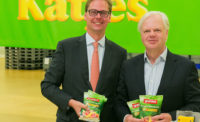Saying ‘Si’ to Sweets
By Elizabeth Brewster
Latin treats move into the mainstream as large and
mid-sized players tap into this growth segment.
Candy makers are
sweetening the pot for both Hispanic and non-Hispanic consumers with a new
wave of confections catering to both tastes.
While major non-Hispanic players like Hershey and
Masterfoods are increasingly reaching out to Hispanic consumers, Latin
giant Montes is looking to cross over into mainstream U.S. distribution
channels with its popular Mexican candies. And Sonrics, another major
player in Mexico, is rolling out an extensive product line for U.S.
consumers. In addition, smaller U.S. confectioners are launching their own
versions of Latin-inspired treats sparked by exotic spicy and fruit
flavors.
“The Hispanic market is growing four times faster
than the total population. It’s so broad and far-reaching that . . .
I don’t think you can miss [by marketing to Hispanic
consumers],” says Joan Buyce, public relations manager for
Masterfoods USA in Hackettstown, N.J.
In fact, the 39 million U.S. Hispanics now make up 13%
of the total population, and that’s by far the biggest ethnic segment
in the country. Two-thirds of this population is Mexican, with others from
Central America, South America and the Caribbean, according to New American
Dimensions, a Los Angeles-based ethnic marketing company.
| Hispanic Candy Penetration in Los Angeles 2004 | |||
| Candy Category | Overall Population | Non-Hispanic Households | Hispanic Households |
| Total candy | 92.5 | 96.0 | 85.1 |
| Non-chocolate | 74.5 | 78.9 | 64.9 |
| Chocolate | 78.3 | 85.5 | 62.9 |
| Chocolate-special | 46.7 | 52.9 | 33.5 |
| Chocolate-miniatures | 47.9 | 57.3 | 27.9 |
| Lollipops | 23.3 | 21.6 | 27.1 |
| Breath sweeteners | 26.8 | 30.1 | 19.6 |
| Source: ACNielsen Homescan Los Angeles Hispanic Panel 2004 report | |||
Numbers like those were part of the reason Hershey
Foods Corp. in Hershey, Pa., scooped up Mexico-based Grupo Lorena last
fall. The $30 million company heats up the spicy candy market in Mexico
with its Pelon Pelo Rico brand, a soft tamarind candy that consumers push
out of its container with a plunger, designed to look like hair coming out
of a character’s head.
“The acquisition of Lorena by Hershey brings
additional distribution opportunities for both companies’ product
lines,” says Octavio Flores, business manager for the Lorena product
line and Hispanic independent channels at Hershey. “Lorena’s
Hispanic trade channels have now added Hershey’s traditional
products, while some of Hershey’s traditional channels are now
enjoying some of Lorena’s products, including Pelon Pelo
Rico.”
Thalia partnership
Hershey is also creating its own products and flavors
specifically targeted to the U.S. Latino community, particularly the
Dulceria Thalia line launched last fall as part of a multiyear partnership
with Mexican singer and actress Thalia Sodi. The new line includes dulce de
leche Kisses, chocolate cookie mix miniatures, and Jolly Rancher lollipops
in both tropical fruit and hot and spicy flavors. The newest Dulceria
offering, rolled out in February 2005, is Cajeta Elegancita, a
chocolate-covered bar of crispy wafer sticks layered with cajeta flavoring
(the Mexican version of the caramel flavor that’s called dulce de
leche in most Latin countries).
Another hot new Latin-flavored product is
Masterfoods’ new Salsagheti, launched in February under its
Mexico-based Lucas brand, acquired in 2001. A huge hit in Mexico, where it
was introduced in August 2003, Salsagheti combines hot chile-coated
watermelon candy straws with a pouch of Lucas Gusano tamarind sauce for
consumers to pour on top.
“Interactive candies are a big trend [in Mexican
confections],” says Masterfoods’ Buyce. “Squeezable
liquid candy, lollipops, candy paste and these types of products make it
really fun for consumers.”
Winning flavor trio
Most of the Lucas products marketed in the United
States incorporate a combination of three popular Hispanic flavors: chile,
tamarind and chamoy (apricot), says Buyce. By sticking with flavors that
Hispanic consumers associate specifically with their culture, she adds, the
products appeal to traditional Latin values of maintaining strong family
and community ties.
The Sonrics lineup includes plenty of flavor pairings.
The Rockaleta Lollipop has alternate chile layers with a mango gum center
and Rockaleta Dark is a lollipop with alternate chile layers and a tamarind
center.
Although spicy and tropical fruit flavors are most
commonly associated with Hispanic candies, milk-based products are rapidly
coming into their own, says Carlos Nava, president of Montes USA in Irving,
Texas, the U.S. division of the Mexico-based candy company.
“We are really pushing and having a lot of
success with our milk-based product lines,” says Nava.
“Hispanics, like the general population, recognize dairy products as
something that’s nutritious and good for you. And with [both Hispanic
and non-Hispanic] mothers purchasing candies for the household, the option
to buy something healthier is certainly a good thing.”
Montes USA has added a milk caramel lollipop to its
U.S. product line, along with milk-based toffees in three flavors: pecan,
coconut, and coffee. This year, the company is also debuting a U.S. caramel
candy filled with guava, a fruit flavor that Nava says has lots of
potential for crossover appeal to the non-Hispanic market.
“One of our big goals for 2005 is to start
capitalizing on some of our crossover opportunities,” he says.
“We think Montes is uniquely positioned, because we don’t
necessarily specialize in the more exotic flavors like chile and tamarind.
If you took the wrappers off [our candies], you wouldn’t be able to
tell what country they were from.”
While Nava says that Montes is likely to head into the
mainstream market with bilingual packaging, other U.S. up-and-comers favor
marketing to both groups with separate packaging as a means of asserting
their heritage. San Diego-based Chargers Candy Co. has just begun shipping
its new Chili + Lime gum to non-Hispanic markets in its distinctive
battery-shaped tin, with English-language packaging. For the Hispanic
market, vice president Daphne Nissanoff Gerendash says the gum will hit
store shelves in a Spanish-language peg bag.
Positioned for value
“The American market is all about convenience and
interesting packaging,” she says. “The Hispanic market is more
about value. Our packaging is tailored very specifically for each
market.”
The Chargers Chili + Lime gum—which Nissanoff
Gerendash says is the first sour-spicy bubble gum on the market—taps
into the growing influence of Hispanic flavors on American palates, and
also caters to traditional Latin tastes. “Americans have developed a
very nice taste for the Hispanic flavor profile,” she says. “We
felt the timing was right to hit the American market and the Hispanic
market simultaneously.”



.jpg?height=200&t=1650655244&width=200)

